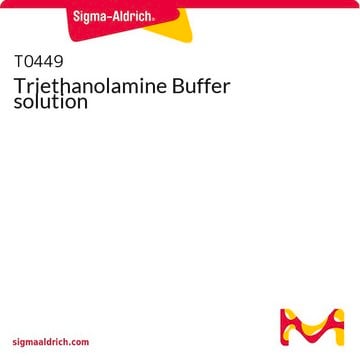Products may be shipped at a different temperature than the recommended long-term storage temperature. If the product quality is sensitive to short-term exposure to conditions other than the recommended long-term storage, it will be shipped on wet or dry-ice. If the product quality is NOT affected by short-term exposure to conditions other than the recommended long-term storage, it will be shipped at ambient temperature. As shipping routes are configured for minimum transit times, shipping at ambient temperature helps control shipping costs for our customers. For more information, please refer to the Storage and Transport Conditions document: https://www.sigmaaldrich.com/deepweb/assets/sigmaaldrich/marketing/global/documents/316/622/storage-transport-conditions-mk.pdf
T58300
Triéthanolamine
reagent grade, 98%
Synonyme(s) :
2,2′,2′′-nitrilotriéthanol, Tris(2-hydroxyéthyl)amine
Sélectionner une taille de conditionnement
Sélectionner une taille de conditionnement
About This Item
Produits recommandés
Qualité
reagent grade
Niveau de qualité
Densité de vapeur
5.14 (vs air)
Pression de vapeur
0.01 mmHg ( 20 °C)
Essai
98%
Forme
viscous liquid
Température d'inflammation spontanée
600 °F
Limite d'explosivité
8.5 %
Indice de réfraction
n20/D 1.485 (lit.)
Plage de pH utile
7.3-8.3
pKa (25 °C)
7.8
pb
190-193 °C/5 mmHg (lit.)
Pf
17.9-21 °C (lit.)
Solubilité
soluble 149 g/L at 20 °C (completely)
Densité
1.124 g/mL at 25 °C (lit.)
Groupe fonctionnel
amine
hydroxyl
Chaîne SMILES
OCCN(CCO)CCO
InChI
1S/C6H15NO3/c8-4-1-7(2-5-9)3-6-10/h8-10H,1-6H2
Clé InChI
GSEJCLTVZPLZKY-UHFFFAOYSA-N
Vous recherchez des produits similaires ? Visite Guide de comparaison des produits
Catégories apparentées
Description générale
Application
- A nitrogen precursor in the preparation of carbon dot derived nanomaterials.[2]
- A cross-linking agent in the synthesis of methylaluminoxane pre-catalysts applicable in the polymerization of ethylene.[3]
- A reducing agent to synthesize Ag nanoparticles of biological importance.[4]
Code de la classe de stockage
10 - Combustible liquids
Classe de danger pour l'eau (WGK)
WGK 1
Point d'éclair (°F)
354.2 °F - closed cup
Point d'éclair (°C)
179 °C - closed cup
Équipement de protection individuelle
Eyeshields, Gloves, type ABEK (EN14387) respirator filter
Faites votre choix parmi les versions les plus récentes :
Déjà en possession de ce produit ?
Retrouvez la documentation relative aux produits que vous avez récemment achetés dans la Bibliothèque de documents.
Les clients ont également consulté
-
How is shipping temperature determined? And how is it related to the product storage temperature?
1 answer-
Helpful?
-
-
How can I determine the shelf life / expiration / retest date of this product?
1 answer-
If this product has an expiration or retest date, it will be shown on the Certificate of Analysis (COA, CofA). If there is no retest or expiration date listed on the product's COA, we do not have suitable stability data to determine a shelf life. For these products, the only date on the COA will be the release date; a retest, expiration, or use-by-date will not be displayed.
For all products, we recommend handling per defined conditions as printed in our product literature and website product descriptions. We recommend that products should be routinely inspected by customers to ensure they perform as expected.
For products without retest or expiration dates, our standard warranty of 1 year from the date of shipment is applicable.
For more information, please refer to the Product Dating Information document: https://www.sigmaaldrich.com/deepweb/assets/sigmaaldrich/marketing/global/documents/449/386/product-dating-information-mk.pdfHelpful?
-
-
Is this a product solid form or in liquid form ??
1 answer-
As mentioned in the 'PROPERTIES' section, this product is supplied as a viscous liquid. The melting point range is 17.9 - 21 °C. The product may solidify at lower temperatures. Warming the material to reliquify will not impact the integrity of the material.
Helpful?
-
-
Why was the product T58300 Triethanolamine received in a solid state when it is supposed to be a liquid?
1 answer-
Triethanolamine has a low melting point of 17.9 - 21°C, and it is a viscous liquid above 22 degrees Celsius. During the coldest months of the year, if the atmospheric temperature is below 21 degrees Celsius, this liquid product will arrive in a solid state. To remedy this, place the bottle in a water bath above 22 degrees Celsius to melt the product. The quality of the product will not be affected by status changes.
Helpful?
-
-
What is the boiling point of Product T58300, Triethanolamine?
1 answer-
The boiling point is not determined by Sigma-Aldrich, but is reported to be 190-193°C at a reduced pressure of 5mm Hg.
Helpful?
-
-
Product T58300, Triethanolamine, was received as a solid and it usually arrives as a liquid. Is the product still acceptable?
1 answer-
Yes, the product is still acceptable. Triethanolamine has a melting point of 17.9-21°C, which is near room temperature. The item ships under ambient conditions. As a result, it may arrive as a solid when exposed to cold temperatures (especially during the winter months). Gentle heating in a warm water bath will easily convert the material back into its expected viscous liquid appearance.
Helpful?
-
-
How can I dilute Product T58300, Triethanolamine?
1 answer-
According to the chemicals encyclopedia published by the Royal Society of Chemistry (which we also offer as product Z705322), triethanolamine is expected to be miscible with water, methanol or acetone.
Helpful?
-
-
What is the Department of Transportation shipping information for this product?
1 answer-
Transportation information can be found in Section 14 of the product's (M)SDS.To access the shipping information for this material, use the link on the product detail page for the product.
Helpful?
-
-
What kind of gloves would be recommended when working with Product T58300, Triethanolamine?
1 answer-
When working with the material, we would recommend neoprene, nitrile or butyl gloves. For example, the Best® butyl, ChemMaster™ or N-DEX® gloves.
Helpful?
-
Active Filters
Notre équipe de scientifiques dispose d'une expérience dans tous les secteurs de la recherche, notamment en sciences de la vie, science des matériaux, synthèse chimique, chromatographie, analyse et dans de nombreux autres domaines..
Contacter notre Service technique





